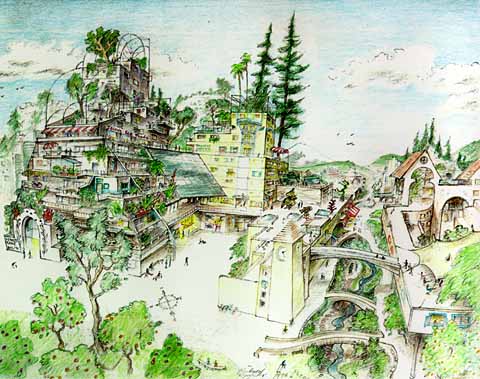I just read Ecocities by Richard Register. His definition of an eco city is:
•An ecologically healthy human settlement modeled on the self-sustaining resilient structure and function of natural ecosystems and living organisms.
•An entity that includes its inhabitants and their ecological impacts.
•A subsystem of the ecosystems of which it is part — of its watershed, bioregion, and ultimately, of the planet.
•A subsystem of the regional, national and world economic system.
Unlike Eco Brooklyn, who is a small New York green builder focused on the micro impact of single buildings, the work that Register deals with is the macro construction of entire cities.

But unlike your typical city that is mostly built by a diverse group of different builders who are not communicating much with each other, Register proposes a city that is built from the start with a unifying vision.
This unifying vision is everything you would expect from an eco city – pedestrian passages, lots of greenery, public transport – but the key point that struck me is that such a design needs a very clear macro vision to succeed.
This would mean for example building a massive framework of platforms that later gets filled in by smaller builders, much like an old sunken boat becomes a lively community of plants and animals.
But the key thing I took from this is that you have to build the boat. This requires the large scale construction and machinery that is so often associated with very un-ecological skyscraper construction.
My solution to green building was to stay small since I can make a direct difference. Register offers the idea that we need to build big in order to make a big impact.
The main point is that an eco city requires a lot more infrastructure planning that I had envisioned. I saw an eco city as a grass roots sort of thing where things grew from the ground up and where most power and waste was dealt with on each localized site. But according to him an eco city
involves clustered condensed housing that of course has what I mention but that also takes advantage of economy of scale and centralized systems as well.
It would mean that the main structure of the city would be laid out like one single building. Similar to Paolo Soleri’s construction but on a much bigger scale. It makes a lot of sense. But the one issue is that it would require large style construction similar to skyscraper style…
